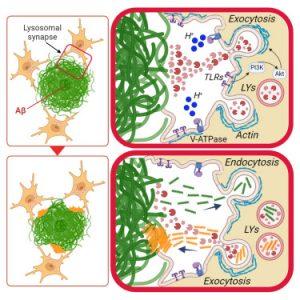In a new study, researchers revealed a mechanism of digestive exophagy, which pave the way for therapies to enhance microglial plaque-clearing capabilities (Figure 1). Microglia, the immune cells of the brain, have been found to partially digest large amyloid plaques, a hallmark of Alzheimer’s disease, by forming an external stomach-like structure to release digestive enzymes. The study also sheds light on how microglia may inadvertently contribute to the spread of plaques, providing insights into Alzheimer’s progression.
Microglia are scavenger cells responsible for maintaining brain health by consuming debris, microbes, and dead cells. They typically engulf smaller particles into vesicles that are digested by lysosomes—organelles containing powerful enzymes. However, the size of amyloid plaques, far larger than microglia themselves, raised questions about how these cells manage such aggregates.
The study discovered that microglia use a mechanism akin to one observed in macrophages, immune cells in other parts of the body. When macrophages encounter objects too large to engulf, such as atherosclerotic plaques, they form a partially sealed external digestive space to break down the material gradually. Similarly, microglia latch onto large amyloid plaques, create a semi-enclosed space around them, and release lysosomal enzymes to digest the plaques in situ. The enzymes acidify the space, activating the digestion process.
While microglia can break down plaques, they are also known to contribute to plaque formation, presenting a paradox. The study suggests that digestive exophagy might inadvertently aid in spreading plaques across the brain. In this study, microglia loaded with amyloid fibrils were placed near larger plaques, and the cells expelled the fibrils toward the plaques during the digestion process. This behaviour suggests that microglia may inadvertently deposit “seeds” of amyloid fibrils into new areas, potentially propagating plaque formation.
By exploring the mechanisms of microglial activity further, researchers aim to find ways to tip the balance toward effective plaque clearance while mitigating the unintended consequences of plaque propagation. This dual understanding of microglia’s roles provides a foundation for developing targeted therapies to slow or prevent the progression of Alzheimer’s disease.
Journal article: Jacquet. R.G., et al, 2024. Microglia degrade Alzheimer’s amyloid-beta deposits extracellularly via digestive exophagy, Cell Reports.
Summary by Stefan Botha











